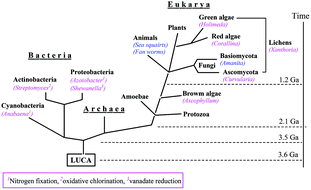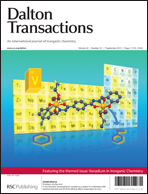The future of/for vanadium
Abstract
Vanadium compounds are stored or employed by several groups of bacterial and eukaryotic organisms. Two types of vanadium-dependent enzymes have so far been characterised: vanadate-dependent haloperoxidases from fungi, lichens, marine macroalgae and Streptomyces bacteria, and vanadium nitrogenases in proteo- and cyanobacteria. Several bacterial strains can employ vanadate(V) as an external electron acceptor in respiration, reducing vanadate to VO2+ and thus contributing to the mineralisation of vanadium and to the detoxification of vanadate-contaminated water. Amanita mushrooms and many sea squirts accumulate vanadium, without the importance of this practise being well understood. Further, the analogy between vanadate and phosphate implicates an interference of vanadate with metabolic processes involving phosphate, suggesting a regulatory role for vanadate in most if not all organisms, including humans, but also hinting at toxic effects at unphysiologically high vanadate concentrations. The antidiabetic effect of vanadium compounds is probably related to the phosphate–vanadate antagonism, as is the potentiality of vanadate in the amelioration of cardiovascular affliction. The anti-cancer action of vanadium compounds and their in vitro activity towards the protozoa causing amoebiasis, leishmaniasis and Chagas’ disease again may be rooted in the intervention of vanadate with the activity of phosphatases and kinases. In addition, most likely the ability of vanadate(V) and oxidovanadium(IV) to regulate the cellular production of reactive oxygen species comes in, thus influencing cellular signalling. Future developments of vanadium chemistry are likely to emphasize topics related to biological, environmental and medicinal aspects. Condensation of monovanadate results in the formation of oligovanadates, polyvanadates and finally colloidal and solid vanadium oxides that, in part, convey bio-mimetic functions comparable to those of simple vanadate, including its catalytic potential as an active centre in haloperoxidases and the lethal action against viruses, bacteria and protozoan parasites. Decavanadate has been shown to be stabilised by docking to proteins, and by integration into nanoscopic water pools of intracellular compartments, modelled by reverse micelles. The well established and approved use of vanadium oxides in, amongst other applications, catalysis has been recently impacted by the elucidation of the active surface species – VOx – of catalysts based on mixed vanadium oxides, and vanadium oxides on supports. Finally, materials based on vanadium oxides and vanadates play an increasingly important role as cathode materials in high density lithium batteries. An example is Ag2VO2PO4, which, in the discharge process, is reduced to Li3.2VO2PO4 and Ag. Oncoming developments in vanadium chemistry thus include oxide-based materials.

- This article is part of the themed collection: Vanadium in Inorganic Chemistry

 Please wait while we load your content...
Please wait while we load your content...